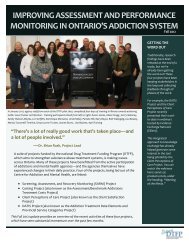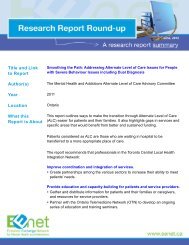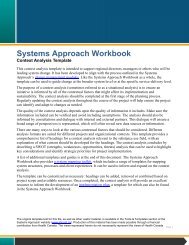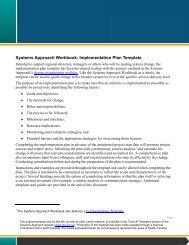Implementation of Early Psychosis Intervention Program ... - EENet
Implementation of Early Psychosis Intervention Program ... - EENet
Implementation of Early Psychosis Intervention Program ... - EENet
You also want an ePaper? Increase the reach of your titles
YUMPU automatically turns print PDFs into web optimized ePapers that Google loves.
58Table 19: Working with inpatient units: <strong>Implementation</strong> by program typeSurvey Question Response All Large Small Hospital CommunitySitesQ94: How <strong>of</strong>ten able to% sites implementing 71 77 62 83 52implement this element‘most <strong>of</strong> the time’Large: catchment area population > 100,000 population (31 program sites)Small: catchment area population < 100,000 population (21 program sites)Hospital: hospital is parent organization (30 program sites)Community: community agency is parent organization (22 program sites).Main challenges to working with inpatient units noted by programs:o Psychiatric care difficulties. For instance, confusion over which psychiatrist (inpatient or EPI)provides care; differences between EPI and inpatient psychiatrist approaches to illnessmanagement (e.g., some psychiatrists do not support EPI, changing client’s medications).o Staff attitudes in inpatient unit or emergency department and their understanding <strong>of</strong>community support programs.o Client negative responses to hospitalization (e.g., minimizing symptoms to shorten admission,instability)o Poor communication between inpatient unit and EPI program, for example, EPI program staffnot allowed to view documentation <strong>of</strong> admitted clients, not notified that client has beenadmitted until after discharge or no protocol for communication.o EPI program not involved in discharge planning from inpatient unit and client not prepared orwell enough to be discharged.o EPI program resource limitations for visiting inpatient units, which include staff time,geography and travel.o Access when inpatient unit is in distant location.Strategies suggested by programs for working with inpatient units:o Conduct proactive outreach to build rapport with hospital team, educate about the EPIprogram and establish processes and communication strategies for client management.o At EPI client program admission, obtain client/family consent to communicate relevantinformation with inpatient unit if needed.o Participate in unit rounds, care planning meetings and discharge planning; visit clientsthroughout their admission.o If a discharge referral is received, visit client on the unit and assess suitability for program.o These collaborations may require authorizations and formal protocols between hospital unitand EPI program.o Hospital sponsored EPI programs reported some home organization benefits – e.g.,notification if EPI client is admitted to their hospital, access to unit charts for EPI clients andother documentation, communication between EPI program and inpatient physicians.What would help programs for working with inpatient units:o Improved communication between EPI programs and inpatient units, at time <strong>of</strong> admission,during treatment in inpatient unit and at time <strong>of</strong> discharge planningo Access to electronic charts or inpatient program notes – may require policy change.
















